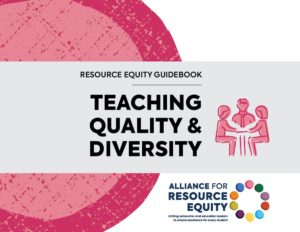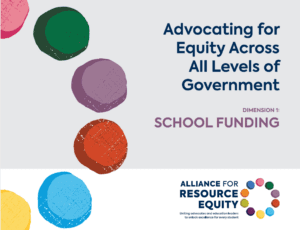The Vision
Each student—including students with higher needs and students of color—attends school in a district that distributes funding based on the needs of its students, by way of flexible and transparent funding systems, so all students can reach high standards and thrive.
Sample Questions to Ask
- After accounting for differences in student need, how does our district’s overall spending level compare to the state average and other peer districts?
- When all funds are included, how does per-pupil spending compare at high-need vs. low-need schools in our district? How does this spending change if Title I funds are excluded?
- Are the formulas that govern the resources that each school receives widely shared and understood?
Take Action With Our Diagnostic Tools
- Use our Resource Equity Diagnostic: Self-Assessment tool to start conversations and build shared understanding across teams.
- Then, analyze your data to better understand the state of resource equity in your district. First, use our Diagnostic Blueprints to learn about what types of analyses to conduct. Then, input your district data into our DIY Analysis Tools to complete these analyses and make meaning of the results.
- Prioritize areas for further inquiry and identify potential root causes and actions using our District Guidebook.
Common Causes of Inequity
- Insufficient District Revenue: When overall funding levels are insufficient, it can limit a district’s ability to different spending based on students’ needs.
- Limited Differentiation: A district’s funding formula may not meaningfully differentiate between schools to meet the unique needs of all students and all schools.
- Insufficient Transparency: Because a district’s funding formula may not be shared broadly in accessible ways, school leaders and the community may not understand which resources each school receives and why.
Related Dimensions
No single dimension of education resource equity can unlock every student’s potential—but when dimensions are combined to meet students’ distinct needs, they are a strong foundation for unlocking better, more equitable experiences in school.
Explore the Diverse Classrooms & Schools dimension, as students of color and students from low-income backgrounds are often concentrated in schools with insufficient funding.
Toolkit
Use our Resource Equity Toolkit to learn more, start a conversation, and take action in your community.

The Education Combination
Learn about education resource equity by discovering 10 dimensions that unlock better, more equitable experiences in school for all students.

Diagnostic Tools And Supports
Identify strengths and gaps in your school system across all 10 dimensions.

Guidebooks
Explore underlying causes of your school system’s challenges and possible actions to improve students’ experiences in school.

Advocating Across Government
Identify who has the power to address equity gaps in your school system and the school district, state and federal levels.

Casemaking Decks
Develop compelling and coherent messaging to “make the case” for addressing resource inequities in your community.
